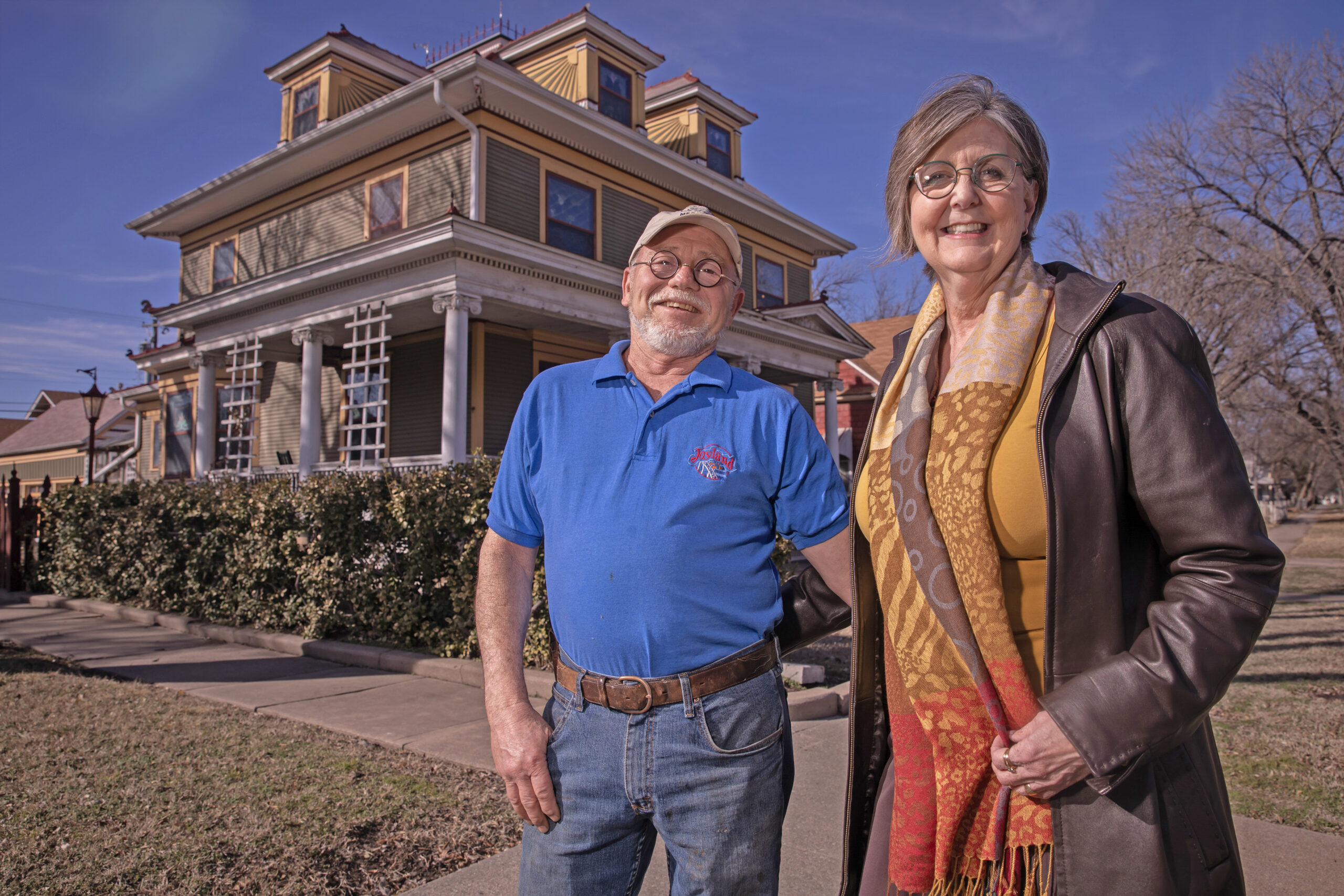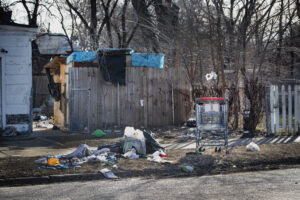As lovers of all things old, Larry and Cathy Mong were thrilled with the home they bought for $50,000 in Wichita 23 years ago: a 1906 Victorian in south central Wichita, less than a mile from the heart of downtown.
The neighborhood was a little rough, but the Mongs had seen similar neighborhoods in the Dallas-Fort Worth area go through the gentrification process.
“We thought in five to 10 years it would be like downtown Dallas, but it isn’t,” Larry Mong said.
In fact, in some respects it seems to have declined. When they moved in, Larry remembers, every home on the block was occupied by owners or renters. Today, six are boarded up. The house two doors down appears headed for demolition, having suffered two major fires set by homeless people. Across the street, the red brick building that once housed Grace Methodist Episcopal Church — added to the National Register of Historic Places in 2006 — is boarded up and its doors welded shut after being taken over by homeless squatters, who also set fires.
Even so, the neighborhood remains attractive for some. Recently, a couple relocating to Wichita from Seattle expressed excitement after touring the house next door to Mong’s, which is listed for sale at $129,000. The couple told Mong it would be worth $600,000 in Seattle.
Elsewhere in south central Wichita, new owners have bought and fixed up derelict homes, duplexes and apartments. In a city where affordable housing is in short supply, south central real estate offers bargains. But can enough people look past its challenges to revive one of the city’s oldest neighborhoods?
Vacant properties, code violation
South central Wichita is usually defined as the area bordered by Kellogg on the north, Harry (or sometimes Pawnee) on the south, Washington on the east and the Arkansas River on the west.
Mong thinks he knows one reason why it hasn’t taken off: unlike Dallas and other bigger cities, Wichita doesn’t have the sort of vehicle traffic that makes people dread a commute from the edge of town or suburbs.
But the neighborhood — nicknamed “SoCe” by some residents — has other issues: vacant and abandoned properties, hotels on south Broadway that attract criminal activity, code violations and a sizeable homeless population.
Generally, its problems seem worse the closer one gets to Broadway and Kellogg.
“I can tell you in that particular area, you’re going to see vacant and boarded up houses, which are ugly but not illegal as long as they’re secure,” said KaLyn Nethercot, neighborhood inspection administrator for the Metropolitan Area Building and Construction Department. “During the summer, a ton of tall grass and weeds, illegal dumping — residential junk and debris — dilapidated housing, abandoned vehicles.”
MABCD, which is a joint city-county agency, responds to complaints rather than proactively looking for code violations, Nethercot said. It works with property owners to correct problems or bills them for work if the city has step in. For owners who are unable to pay, the city offers help through its code enforcement liaison, who can arrange for things like a free dumpster and volunteers to clean up a property.
Mong says that over the past four or five years, the city has stopped enforcing laws against trespassing and breaking and entering in the area, allowing homeless people to take over and damage vacant structures.
“It’s sad,” he said.” I don’t hate the homeless, but if they break into somebody’s house, they’re criminals.”
Nethercot said she couldn’t offer an opinion on whether the problem of homeless squatting is worse in south central than elsewhere, but she’s familiar with what happened at the Grace M.E. building. The city paid to have the building professionally secured so as not to endanger firefighters responding to calls there “day and night.”
“They weren’t trying to burn the place down,” she said of the illegal occupants. “They were trying not to freeze to death.”
Neighboring Movement
South central Wichita is nothing if not diverse.
There are long-established family businesses like Lewis Street Glass and Broadway Mortuary along with smoke shops, used car lots and massage parlors; blocks of well-tended homes and yards and others where code violations and unsafe structures abound; a steady stream of vehicular and foot traffic up and down Broadway. The closings of a succession of supermarkets at Harry and Broadway left a food dessert. One of the city’s key health care safety nets — Guadalupe Clinic — serves the working poor from its longtime home on South St. Francis. The Kansas & Oklahoma Railroad bisects it running alongside Lincoln Street.
Adam Barlow-Thompson sees promise in that diversity. A decade ago, he and his wife paid $60,000 for a house on its western edge. They put another $60,000 into it over the next couple of years. “Now I have a four-bedroom home with a two-car garage,” Barlow-Thompson said. “My property sits next to the river. The monthly mortgage is $600. This seems like a good deal.”
Barlow-Thompson co-founded SoCe Life – officially the SoCe Neighborhood Action Foundation — in 2015 and serves as its executive director. Located at Lincoln and Broadway, the partly faith-based nonprofit is active in south sentral Wichita and other communities and churches across Kansas and the United States promoting what it calls the “Neighboring Movement.” Here, that’s included hosting neighborhood cleanups and get-togethers, building garden boxes and painting fences for residents and encouraging residents to take part in the “8 Front Doors Initiative,” in which people get to know the neighbors living in the eight houses closest to them.
Barlow-Thompson estimates that about 20 percent of the neighborhood’s homes are vacant. “I don’t mean like they’re listed on the market. They’re abandoned.”
In many cases, he said, the previous owners were elderly people who died, leaving the properties to heirs who don’t live in Wichita and for whom selling the property isn’t a high priority.
“When they’re vacant, it really causes issues,” he said.
The hotels on South Broadway also create “a lot of illegal and illicit activity,” he said, but the solution is more nuanced than to “just tear them down,” even if that were possible.
“There are families who live there, and there are people who have fallen through the gaps — it’s their housing.”
Barlow-Thompson wonders if some vacant properties in the neighborhood could be turned into transitional housing for people who need it and speculates that surrounding the hotels with “enough good things” might make their “business model harder to pull off.”
SoCe Life recently bought commercial properties at the intersection of Lincoln and Broadway, across the street from its office, and plan to redevelop it. With the help of grants, the organization has grown its revenue from $88,000 in 2106 to $651,000 in 2022.
Barlow-Thompson notes that the corner of Lincoln and Broadway is a mile from the site where the $300 million Wichita Biomedical Campus is to be built, at 214 S. Topeka (current site of the Wichita Transit Center). The collaboration of Wichita State University and the University of Kansas will bring about 3,000 students and 200 faculty to the area.
“We’re getting closer now than we ever have to actually making some substantial changes,” Barlow-Thompson said.
‘Major projects’?
South central is one of nine neighborhoods the city designates as “formative,” which are “those areas in greatest decline and most in need of reinvestment.” The City Council approved several measures for those areas, including establishing a land bank to acquire and rehabilitate distressed properties, eliminating unsafe structures, creating an Affordable Housing Fund for new construction and renovations and waiving building permit fees.
City Councilman Mike Hoheisel, who represents the neighborhood, said he didn’t know of any properties in south central that have benefited from those programs to date. He did say the city had recently completed a pilot program to catch people who illegally dump debris in the area, often in alleys, by installing cameras. “We are going to go forward and prosecute some of these people we are catching.”
Hoheisel agrees that the neighborhood’s vacant houses are a problem but said the city is limited by law as to what it can do beyond trying to force owners to keep them up to code.
“We have a shortage of houses,” he said. “It would be a good deal if we could actually get those back on the market and people in those houses.”
He sounded optimistic regarding the South Broadway corridor, saying there’s behind-the-scenes work going on there.
“You’re catching us right in the middle of some major projects we have in there.”
The Mongs hope that happens. Their front yard contains a “SoCe Life” sign, and Mong talks admiringly of several new Hispanic neighbors who’ve used their skill in the building trades to turn eyesores bought on the cheap into attractive homes.
“We’ve got to figure out how to get people to invest in this neighborhood.” This article was produced as part of the Wichita Journalism Collaborative, which consists of The Active Age and 10 media and community partners.









